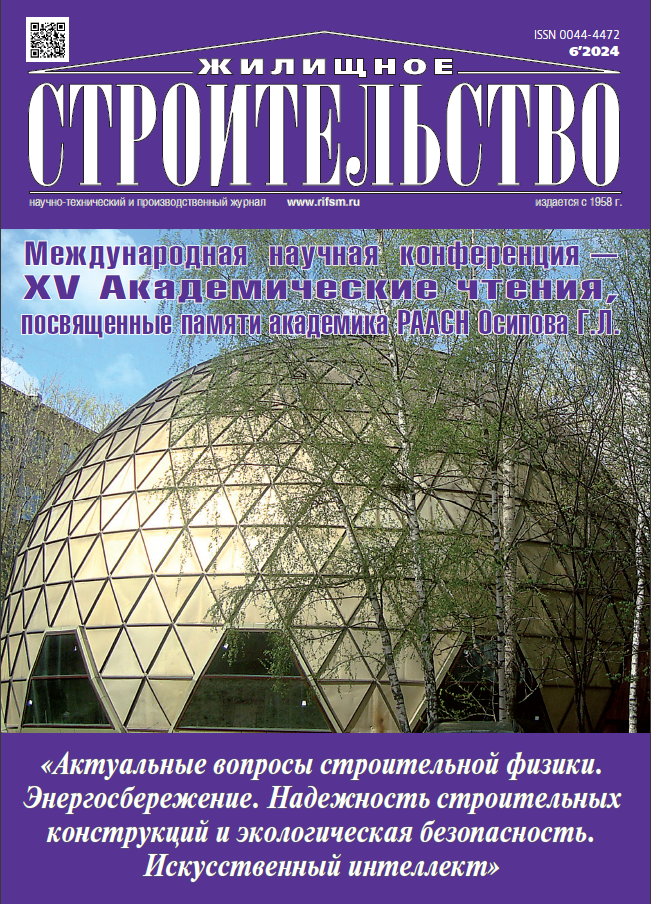Anti-rating of Structural Floor Solutions for Shock Noise Insulation
- Authors: Kryshov S.I.1, Kotelnikov D.E.1, Gradova O.V.2
-
Affiliations:
- Center for Expertise, Research and Testing in Construction
- Scientific-Research Institute of Building Physics of RAACS
- Issue: No 6 (2024)
- Pages: 21-24
- Section: Articles
- URL: https://ter-arkhiv.ru/0044-4472/article/view/634819
- DOI: https://doi.org/10.31659/0044-4472-2024-6-21-24
- ID: 634819
Cite item
Abstract
One of the important characteristics of a comfortable environment for a person’s daily stay is the sound insulation of enclosing structures. Insufficient indicators of sound insulation properties of enclosing structures have a negative impact on human health and work activity. To a large extent, both the physical and psychological state of the body is influenced by the level of shock noise. In order to assess these indicators, multiple tests of various floor structures were carried out to ensure that the index of the reduced shock noise level meets the current regulatory requirements. Various variants of structural solutions of overlaps between rooms in buildings of various purposes, which showed the worst values of the indices of the reduced shock noise level, are considered. The analysis of solutions and research presented in various reference and scientific materials and publications of previous years has been carried out. The dependence of the indices of the reduced level of shock noise of the ceilings on the applied design solutions and test conditions is analyzed. The composition of the floor construction layers is described in detail according to the information provided in the design and working documentation for each object of research. Graphs of the relative position of frequency characteristics and estimated spectra of the reduced level of shock noise under overlap for each considered structure are presented.
Keywords
Full Text
About the authors
S. I. Kryshov
Center for Expertise, Research and Testing in Construction
Author for correspondence.
Email: skryshov@yandex.ru
Candidate of Sciences (Engineering), Head of Department
Russian Federation, 13, Ryazansky Avenue, Moscow, 109052D. E. Kotelnikov
Center for Expertise, Research and Testing in Construction
Email: yorik487@yandex.ru
Lead Engineer
Russian Federation, 13, Ryazansky Avenue, Moscow, 109052O. V. Gradova
Scientific-Research Institute of Building Physics of RAACS
Email: mail@rifsm.ru
Head of Sector No. 42.1 “Acoustic materials and structures”
Russian Federation, 21, Lokomotivniy Driveway, Moscow, 127238References
- Novosel’tsev Yu.P., Chumasova E.V., Shalaginova E.V. Sound insulation of inter-apartment partitions and floors in residential buildings. Society. The science. Innovations (NPK-2018): Collection of articles of the XVIII All-Russian Scientific and Practical Conference. Vyatka State University. 2018, pp. 629–635. (In Russian).
- Kryshov S.I. Problems of sound insulation of buildings under. Zhilishchnoe Stroitel’stvo [Housing Construction]. 2017. No. 6, pp. 8–10. (In Russian).
- Red’ko Yu.B. Measurements of impact noise insulation by internal enclosing structures (floors) under natural conditions. Krovel’nye i izolyatsionnye materialy. 2013. No. 2, pp. 24–27. (In Russian).
- Kryshov S.I., Kotel’nikov D.E., Gradova O.V. Dependence of impact noise insulation on the composition of the structural layers of the floor covering. BST: Byulleten’ stroitel’noi tekhniki. 2021. No. 6 (1042), pp. 16–17. (In Russian).
- Shnurnikova E.P., Azarova S.A. Sound insulation of impact noise by floors with rolled floors. Nauchnye trudy KubGTU. 2021. No. 4, pp. 18–25. (In Russian).
- Porozhenko M.A. Insulation of impact noise by building envelopes. Byulleten’ stroitel’noi tekhniki. 2018. No. 6, pp. 34–35. (In Russian).
- Orlov O.G. Ways to solve the problem of protecting residential premises from impact noise sourcesa. Traditions and innovations in construction and architecture. Natural sciences and technosphere safety: Collection of articles based on the materials of the 72nd All-Russian Scientific and Technical Conference. Samara State University of Architecture and Civil Engineering. 2015, pp. 368–370. (In Russian).
- Kormilitsyn V.I., Ganiev S.R., Pustovgar A.P. Development of new building materials with increased combined properties insulation of impact noise between floors covered. Protection of the population from increased noise exposure: Collection of reports of the All-Russian scientific and practical conference with international participation. Edited by N.I. Ivanov, K.B. Friedman. 2015, pp. 283–285. (In Russian).
- Senan A.M. Evaluation of impact noise insulation by interfloor structures with sand cushioning materials. Protection of the population from increased noise exposure: Collection of reports of the All-Russian scientific and practical conference with international participation. Edited by N.I. Ivanov, K.B. Friedman. 2015, pp. 274–275. (In Russian).
- Shubin I.L. Regulatory documents on energy saving and building acoustics, developed by Scientific-Research Institute of Building Physics of RAACS. Byulleten’ stroitel’noi tekhniki. 2012. No. 2, pp. 7–13. (In Russian).
Supplementary files

















